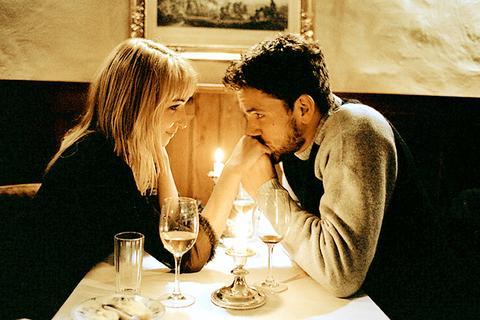The differences between a soap opera and a serious drama are starkly illustrated by Susanne Bier's emotionally devastating Open Hearts. Until the end, when it begins to go soft, the movie takes two strands of soap opera convention -- a life-changing accident and an adulterous affair -- and spins their suds into gold.
One notion that haunts this Danish film is how in the blink of an eye a personal heaven can turn into a hell whose agonies reverberate traumatically through other lives. The fateful blink occurs near the beginning with the opening of a car door. Until then, the movie has pretended to be a romantic idyll. In its blissful opening scene, two young lovers, Joachim (Nikolaj Lie Kaas) and Cecilie (Sonja Richter), who live together in Copenhagen, decide to marry.
Disaster falls when Cecilie drops Joachim off to make a connection for a weekend rock-climbing expedition, and he is struck head-on by a speeding vehicle as he gets out of the car. The guilt-stricken driver, Marie (Paprika Steen), accompanied by her sullen teenage daughter, Stine (Stine Bjerregaard), frantically tries to help and telephones her husband, Niels (Mads Mikkelsen), a doctor who works at the hospital where Joachim is taken.

PHOTOS: YIN HUI
Joachim survives, but his spine is crushed, leaving him permanently paralyzed from the neck down. The bad news is delivered curtly, and as it sinks in, Joachim seems to wither before your eyes.
Because Open Hearts follows the austere rules of the Danish filmmaking collective Dogma 95, it purveys a documentary-style realism that dilutes any lingering soap opera gloss. The rough-hewn visual style matches the bite of Anders Thomas Jensen's screenplay, which pounces on all the painful issues of affliction, sex and death that you half wish the movie would sidestep.
Joachim does not accept his fate stoically. Recognizing that his athletic days are over and that his sex life is finished, he furiously lashes out at the world. To Cecilie he paints a verbally graphic scenario of the withering of his limbs and sex organs. Her tearful assertions of loyalty are taken as humiliating affronts, and he repeatedly rebuffs her overtures until she retreats.

Kaas is so intimately attuned to his character's inner life that you can see the light leave Joachim's eyes and his face metamorphose from scrubby, teddy-bear handsome into an ugly mask of resentment and despair. As his fury mounts, he becomes both monstrous and painfully sympathetic, and the movie puts you in the uncomfortable shoes of someone who empathizes with his rage (who wouldn't have the same initial reaction in Joachim's position?) but is powerless to help. The film deliberately allows his bitter tirades to run on long enough to test your patience and make you want to turn away and flee.
Once Cecilie has withdrawn, Joachim focuses his rage on a nurse who administers physical therapy and whom he taunts with merciless insults. But she can give as good as she gets, and it becomes clear that absorbing the brunt of his fury without cracking is part of her demanding job.
Open Hearts has a second drama up its sleeve. When Cecilie, rejected and at a loss over what to do, reaches out to Niels for comfort, the young doctor obliges with the blessing of his guilt-stricken wife. Cecilie is younger and prettier than Marie, and her need for comfort unexpectedly kindles Niels's desire. Suddenly a stable, monogamous marriage, which has produced three children, begins to unravel.

Stine, who was recently dumped by her boyfriend and who also blames herself for the accident, intuits the affair the moment it ignites. Marie also senses a change, but she loves Niels so much that she is willing to swallow his lies. As Marie's suspicions deepen, she regards her husband with a fierce, animal vigilance. Steen lends a desperate pathos to the role of a woman fighting to preserve her family. It hurts to realize that her formidable defenses may be no match against the full flame of Niels's passion.
In apportioning blame among its four main characters, Open Hearts is scrupulously even-handed. Mikkelsen's cheating husband is no sleazy lothario but a man struck by lightning, dazedly riding an emotional seesaw, teetering wildly between terror and desire.
If two hard-bitten dramas seem like one load too many for a serious movie to shoulder, Open Hearts makes the point that an accident like Joachim's has an inevitable ripple effect, as crosscurrents of guilt, sympathy and the urge to fix what's broken collide. Ultimately, the film pulls back from the abyss and makes an effort to resolve its conflicts. But once it has come in from the cold, it begins to lose its bite.

May 26 to June 1 When the Qing Dynasty first took control over many parts of Taiwan in 1684, it roughly continued the Kingdom of Tungning’s administrative borders (see below), setting up one prefecture and three counties. The actual area of control covered today’s Chiayi, Tainan and Kaohsiung. The administrative center was in Taiwan Prefecture, in today’s Tainan. But as Han settlement expanded and due to rebellions and other international incidents, the administrative units became more complex. By the time Taiwan became a province of the Qing in 1887, there were three prefectures, eleven counties, three subprefectures and one directly-administered prefecture, with

Taiwan Power Co (Taipower, 台電) and the New Taipei City Government in May last year agreed to allow the activation of a spent fuel storage facility for the Jinshan Nuclear Power Plant in Shihmen District (石門). The deal ended eleven years of legal wrangling. According to the Taipower announcement, the city government engaged in repeated delays, failing to approve water and soil conservation plans. Taipower said at the time that plans for another dry storage facility for the Guosheng Nuclear Power Plant in New Taipei City’s Wanli District (萬里) remained stuck in legal limbo. Later that year an agreement was reached

What does the Taiwan People’s Party (TPP) in the Huang Kuo-chang (黃國昌) era stand for? What sets it apart from their allies, the Chinese Nationalist Party (KMT)? With some shifts in tone and emphasis, the KMT’s stances have not changed significantly since the late 2000s and the era of former president Ma Ying-jeou (馬英九). The Democratic Progressive Party’s (DPP) current platform formed in the mid-2010s under the guidance of Tsai Ing-wen (蔡英文), and current President William Lai (賴清德) campaigned on continuity. Though their ideological stances may be a bit stale, they have the advantage of being broadly understood by the voters.

In a high-rise office building in Taipei’s government district, the primary agency for maintaining links to Thailand’s 108 Yunnan villages — which are home to a population of around 200,000 descendants of the Chinese Nationalist Party (KMT) armies stranded in Thailand following the Chinese Civil War — is the Overseas Community Affairs Council (OCAC). Established in China in 1926, the OCAC was born of a mandate to support Chinese education, culture and economic development in far flung Chinese diaspora communities, which, especially in southeast Asia, had underwritten the military insurgencies against the Qing Dynasty that led to the founding of